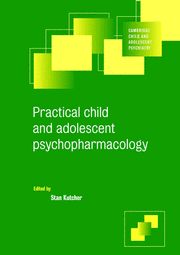Book contents
- Frontmatter
- Contents
- List of contributors
- Preface and acknowledgements
- 1 Child and adolescent psychopharmacology at the turn of the millennium
- 2 Developmental psychopharmacology
- 3 Clinical aspects of child and adolescent psychopharmacology
- 4 Depression
- 5 Bipolar mood disorders: diagnosis, etiology, and treatment
- 6 Schizophrenia and related psychoses
- 7 Obsessive–compulsive disorder
- 8 Anxiety disorders
- 9 Attention-deficit/hyperactivity disorder
- 10 Pervasive development disorder
- 11 Aggressive behavior
- 12 Adolescent substance use disorder
- 13 Tic disorders and Tourette's syndrome
- 14 Eating disorders and related disturbances
- 15 Medical psychiatric conditions
- Index
4 - Depression
Published online by Cambridge University Press: 31 August 2009
- Frontmatter
- Contents
- List of contributors
- Preface and acknowledgements
- 1 Child and adolescent psychopharmacology at the turn of the millennium
- 2 Developmental psychopharmacology
- 3 Clinical aspects of child and adolescent psychopharmacology
- 4 Depression
- 5 Bipolar mood disorders: diagnosis, etiology, and treatment
- 6 Schizophrenia and related psychoses
- 7 Obsessive–compulsive disorder
- 8 Anxiety disorders
- 9 Attention-deficit/hyperactivity disorder
- 10 Pervasive development disorder
- 11 Aggressive behavior
- 12 Adolescent substance use disorder
- 13 Tic disorders and Tourette's syndrome
- 14 Eating disorders and related disturbances
- 15 Medical psychiatric conditions
- Index
Summary
Child and adolescent depression: overview
Does child and adolescent depression exist?
Perhaps surprisingly, this was a contentious question as recently as 15 years ago. One influential line of thought argued that children did not have the cognitive development necessary to become depressed and, while they might have transient dysphoria, did not have long-duration, adult-like depressions. In fact, today's best available estimates suggest that perhaps 2% of prepubertal children and 4% of adolescents may suffer depression at any one time (Fleming and Offord, 1990). Before puberty, there appears to be an approximately equal sex ratio, with an adult-type pattern of more depression in girls than boys beginning in adolescence.
What is the naturalistic course? Is the course severe enough that treatment is warranted?
Obviously, if the naturalistic course is brief enough or mild enough, treatment with its costs and potential side effects may be unwarranted. The data suggest that child and adolescent depression is a persistent and recurring disorder. The natural course of clinic-referred depression appears to last 6–9 months on average with a significant minority lasting years (Kovacs et al., 1984a,b; Ryan et al., 1987). Most children and adolescents who suffer a single episode get future recurrent episodes and grow up to be adults with depression (Harrington et al., 1990, 1993; Kovacs et al., 1984 a,b; Weissman et al., 1999).
Keywords
- Type
- Chapter
- Information
- Practical Child and Adolescent Psychopharmacology , pp. 91 - 105Publisher: Cambridge University PressPrint publication year: 2002
- 1
- Cited by

